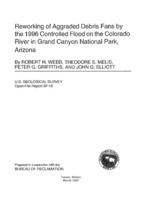Reworking of Aggraded Debris Fans by the 1996 Controlled Flood on the Colorado River in Grand Canyon National Park, Arizona
Links
- Document: Report (pdf)
- Download citation as: RIS | Dublin Core
Abstract
Debris flows from 600 tributaries in Grand Canyon periodically deposit poorly sorted sediment on debris fans along the Colorado River between Lakes Powell and Mead. Before regulation, stable fans and rapids along the river resulted from the interaction of tributary debris flows and large, mainstem floods. Floods in the Colorado River maintained fans and rapids as highly-reworked deposits of boulders and cobbles. After the closure of Glen Canyon Dam in 1963, decreases in stage and stream power associated with reduced annual peak flows drastically reduced the amount of debris-fan reworking. Previous research has shown that modest powerplant releases from Glen Canyon Dam, particularly in combination with tributary floods, can significantly rework aggraded debris fans. These limited flows have entrained boulders up to 1 mo in diameter, although discharges greatly exceeding the maximum powerplant release (946 m3/s) would be required to completely remove most aggraded fans.
From 1987 through 1995, debris flows constricted the Colorado River at the mouths of at least 25 tributary canyons in Grand Canyon National Park, Arizona, creating 2 new rapids and narrowing at least 9 existing riffles or rapids. The highest peak discharge on the Colorado River in Grand Canyon between 1986 and 1996 was 960 m3/s in January 1993. In March-April 1996, we studied the effects of a 7-day flood release that peaked at 1,370 m3/s on 18 recently aggraded debris fans downstream from Glen Canyon Dam.
The largest changes occurred at Badger and Lava Falls rapids, 38 and 312 km downstream from the dam, respectively; several other aggraded debris fans were only slightly changed. Areas of aggraded debris fans decreased by 2 to 42 percent; only the debris fan at Bedrock Rapid, which is controlled by a large bedrock outcrop, increased in area owing to deposition of reworked sediment on the downstream margin. Volumes decreased on 7 of 9 debris fans by 3 to 34 percent. The distal margins of most recently aggraded debris fans became armored with a lag of cobbles and boulders, and the width of the reworked zone on most debris fans increased by 4 to 30 m. Constriction of the river decreased at 11 of 18 debris fans, although some rapids, such as Tanner Rapid, became slightly more constricted at low discharges owing to changes in stage-discharge relations. Velocities on the left and right sides of Lava Falls Rapid decreased by about half, but velocities increased in three other rapids (e.g., Badger Creek Rapid). Stream power per unit width decreased in 9 of 10 rapids because of decreases in water-surface fall and widening of the rapids. Changes in the sizes of upper pool sand bars were inconsistent, although separation bars downstream from the reworked debris fan generally increased in size.
The amount of stream power generated by the controlled flood greatly affected the variability of reworking among the 18 debris fans. For a given discharge, mainstem reworking is expected to vary with channel and debris-fan geometry, the initial particle-size distribution of the deposit, and distance from the dam. The elapsed time between debris flow and the controlled flood also was important because larger particles at older deposits became interlocked, imbricated, and (or) sutured together during smaller dam releases combined with tributary floods in January 1993 and August 1994. The effectiveness of future floods of similar magnitude in reworking debris fans will depend in part on the release history and extent of armoring in the period between the debris flow and the flood. If reworking of debris fans is a criterion for design of future controlled floods, our data support release of a higher peak discharge of shorter duration shortly after constricting debris flows occur.
Study Area
| Publication type | Report |
|---|---|
| Publication Subtype | USGS Numbered Series |
| Title | Reworking of aggraded debris fans by the 1996 controlled flood on the Colorado River in Grand Canyon National Park, Arizona |
| Series title | Open-File Report |
| Series number | 97-16 |
| DOI | 10.3133/ofr9716 |
| Year Published | 1997 |
| Language | English |
| Publisher | U.S. Geological Survey |
| Contributing office(s) | Rocky Mountain Regional Office |
| Description | ii, 36 p. |
| Country | United States |
| State | Arizona |
| Other Geospatial | Colorado River, Grand Canyon |


